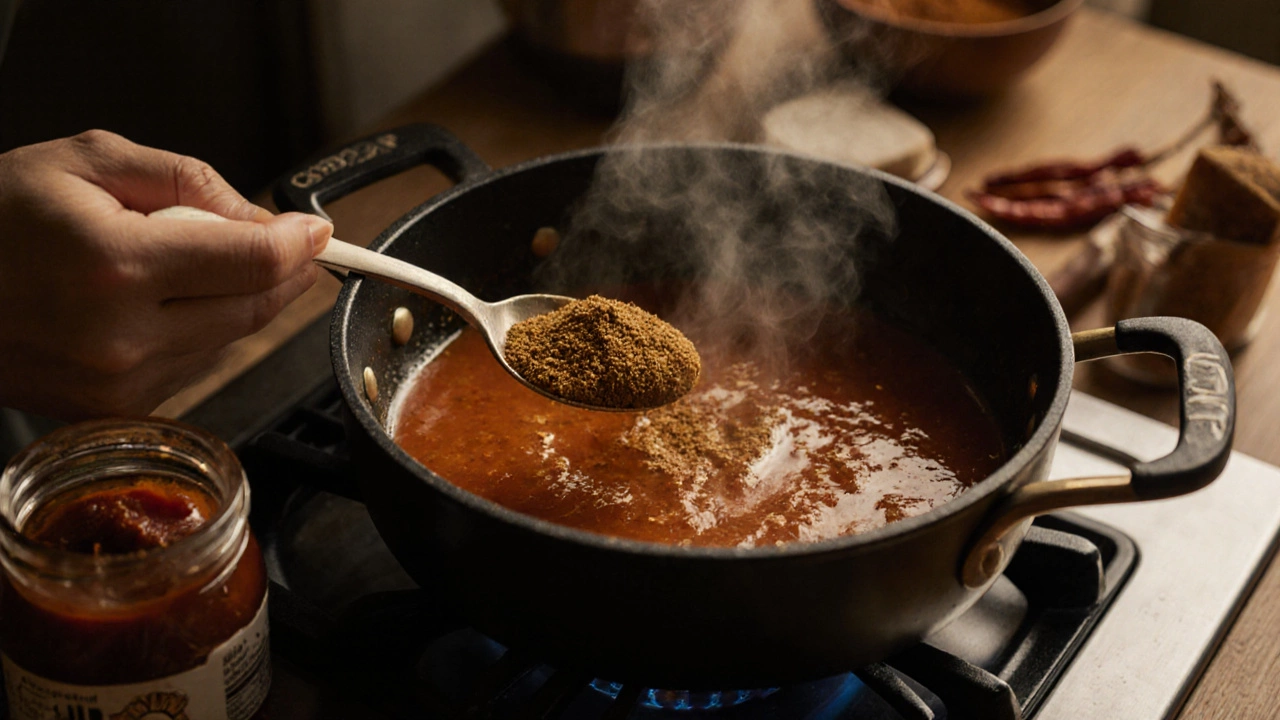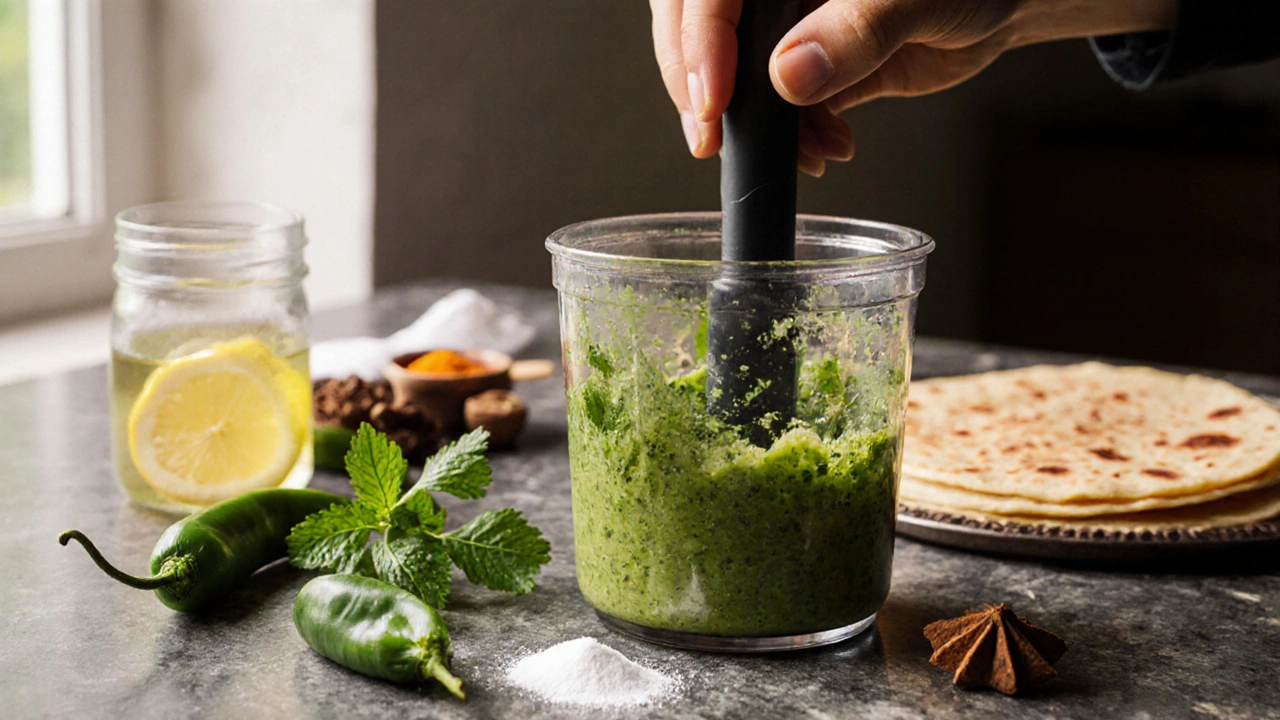Ever reached for a jar of chutney only to find it’s empty? Or maybe you’re cooking an Indian dish and realize you don’t have the right kind-mango, tamarind, mint-and you’re stuck. You don’t need to run to the store. You don’t need to cancel dinner. There are real, practical substitutes that mimic chutney’s flavor, texture, and function. Not just any substitute. The ones that actually work in the dish you’re making.
What makes chutney chutney?
Chutney isn’t just a sauce. It’s a flavor bomb built on three things: acidity, sweetness, and spice. It’s usually made by cooking down fruit or vegetables with vinegar, sugar, and spices like mustard seed, cumin, or chili. The result? A thick, jammy condiment that cuts through rich food-like fried samosas, grilled paneer, or buttery naan.
Think of it as the Indian version of relish, but with more depth. A mango chutney isn’t just sweet-it’s tangy from tamarind, spicy from green chilies, and earthy from toasted cumin. A coconut chutney is creamy, nutty, and sharp with lime. You can’t replace it with plain ketchup and call it done.
Best substitute: Mango salsa
If you’re out of mango chutney, reach for a fresh mango salsa. It’s the closest you’ll get without cooking. Dice ripe mango, red onion, jalapeño, cilantro, and lime juice. Add a pinch of salt. That’s it.
It won’t be as thick or caramelized as cooked chutney, but it delivers the same bright, fruity-tangy punch. Use it on tacos, grilled chicken, or even with plain yogurt rice. The texture is looser, but the flavor profile matches perfectly. In fact, many Indian households keep mango salsa on hand during summer when mangoes are in season.
Second best: Sweet and sour sauce (Chinese style)
Yes, the kind you get with spring rolls. It’s not traditional, but it’s surprisingly close. Most sweet and sour sauces are made with sugar, vinegar, pineapple, and a touch of garlic or chili. That’s the same base as many Indian mango chutneys.
Heat it up in a pan with a teaspoon of ground cumin and a pinch of ground coriander. Let it simmer for two minutes. You’ll get a thick, glossy sauce that clings to samosas and works as a dip for pakoras. It’s not homemade, but it’s a pantry lifesaver when you’re in a pinch.
Third option: Tomato chutney (if you have tomatoes)
Tomato chutney is a staple in South Indian homes. If you have tomatoes, onions, garlic, mustard seeds, curry leaves, and tamarind paste, you can make a quick version in 15 minutes. Simmer chopped tomatoes with a teaspoon of tamarind paste, a pinch of jaggery or brown sugar, and a teaspoon of mustard seeds popped in oil. Add chopped green chilies.
This isn’t mango, but it has the same balance: sweet, sour, spicy. It’s thicker than tomato sauce, more complex than ketchup. Use it on idli, dosa, or even scrambled eggs. If you’ve ever had a South Indian breakfast, you’ve had this.

Fourth: Pico de gallo + a pinch of spice
Pico de gallo is fresh, raw, and chunky. It’s not cooked, so it lacks the jammy texture of chutney. But if you mix in a teaspoon of brown sugar, a splash of apple cider vinegar, and a pinch of ground cumin, it transforms. The salt from the tomatoes, the crunch from the onion, the heat from the chili-all of it mirrors the layers in a fresh mint or coriander chutney.
It’s not perfect, but it’s the best raw alternative. Use it as a topping for grilled tofu or as a side for dal rice. It won’t replace a coconut chutney on a dosa, but it’ll do in a pinch.
Fifth: Apple butter with a twist
Apple butter is thick, sweet, and slightly tart. It’s made by slow-cooking apples with spices like cinnamon and cloves. Sounds far from chutney? Not if you add a dash of vinegar and a pinch of chili flakes.
Stir in a teaspoon of lemon juice and a quarter teaspoon of ground cumin. Heat it gently. Now you’ve got something that mimics the texture and sweetness of mango chutney. It’s not Indian, but it works on cheese toast, roasted pork, or even as a glaze for baked sweet potatoes. In New Zealand, where apples are abundant, this trick is common in kitchens that blend cultures.
What NOT to use
Don’t use plain ketchup. It’s too sweet, too acidic, and lacks depth. It’s a sugar-vinegar-tomato paste with no spice or complexity.
Don’t use jam. Even mango jam. It’s just fruit and sugar. No vinegar. No spice. No texture. It’ll make your dish cloying, not balanced.
Don’t use pesto. It’s herbal, oily, and nutty. That’s a different flavor universe.

How to choose the right substitute
Ask yourself: what’s the chutney doing in this dish?
- If it’s cutting through fat (like with fried snacks), go for something acidic and sharp-mango salsa or sweet and sour sauce.
- If it’s adding sweetness to balance spice (like with spicy dal), use apple butter with vinegar or tomato chutney.
- If it’s a fresh garnish (like on a dosa), pick pico de gallo or fresh mint-coriander mix.
You don’t need to match the exact ingredient. You need to match the role.
Make your own quick chutney next time
Chutney is easy to make. You don’t need fancy equipment. A blender and a saucepan are enough.
For a 5-minute mint chutney: blend 1 cup fresh mint, 1/2 cup cilantro, 1 green chili, 1 tablespoon lemon juice, 1 teaspoon sugar, and a pinch of salt. Add water to thin it. Done.
For a 10-minute tamarind chutney: soak 2 tablespoons tamarind pulp in warm water for 10 minutes. Strain. Cook with 1/4 cup jaggery, 1/2 teaspoon cumin, and a pinch of chili powder. Simmer until thick. Cool. Store in the fridge.
Keep a jar in your fridge. You’ll never run out again.
Final thought: Chutney is flexible
There’s no single ‘right’ substitute. Chutney itself varies wildly across India-sweet in the north, spicy in the south, coconut-based in the west, fermented in the east. The point isn’t to replicate it exactly. It’s to recreate the balance: sweet, sour, spicy, textured.
Use what you have. Taste as you go. Adjust. That’s the real lesson of chutney-not the recipe, but the instinct.
Can I use salsa instead of chutney?
Yes, especially mango salsa. It has the same fruity, tangy, spicy profile as mango chutney. It’s not cooked or thickened, so it won’t cling the same way, but it works perfectly as a fresh topping on samosas, grilled meats, or rice bowls.
Is chutney the same as relish?
They’re cousins, not twins. Relish is usually made from pickled vegetables-like cucumbers or corn-and has a sharper, vinegar-forward taste. Chutney uses fruit, more sugar, and warm spices like cumin and mustard. Chutney is richer, sweeter, and more complex.
What’s the closest thing to coconut chutney?
Try blending 1/2 cup unsweetened shredded coconut with 2 tablespoons yogurt, 1 tablespoon lime juice, a pinch of salt, and a small green chili. Blend until smooth. It won’t be fermented like traditional South Indian versions, but it’s creamy, tangy, and nutty-close enough for most dishes.
Can I use pesto as a chutney substitute?
No. Pesto is herbal, oily, and nutty. Chutney is fruity or vegetable-based, sweet-sour-spicy, and often thick. The flavors don’t align. Pesto belongs on pasta, not on dosa.
How long does homemade chutney last?
Most homemade chutneys last 2-3 weeks in the fridge if stored in a clean, airtight jar. If you cook it down until very thick and add vinegar and sugar, it can last up to 2 months. Freeze it in ice cube trays for longer storage-pop out a cube when you need a spoonful.

